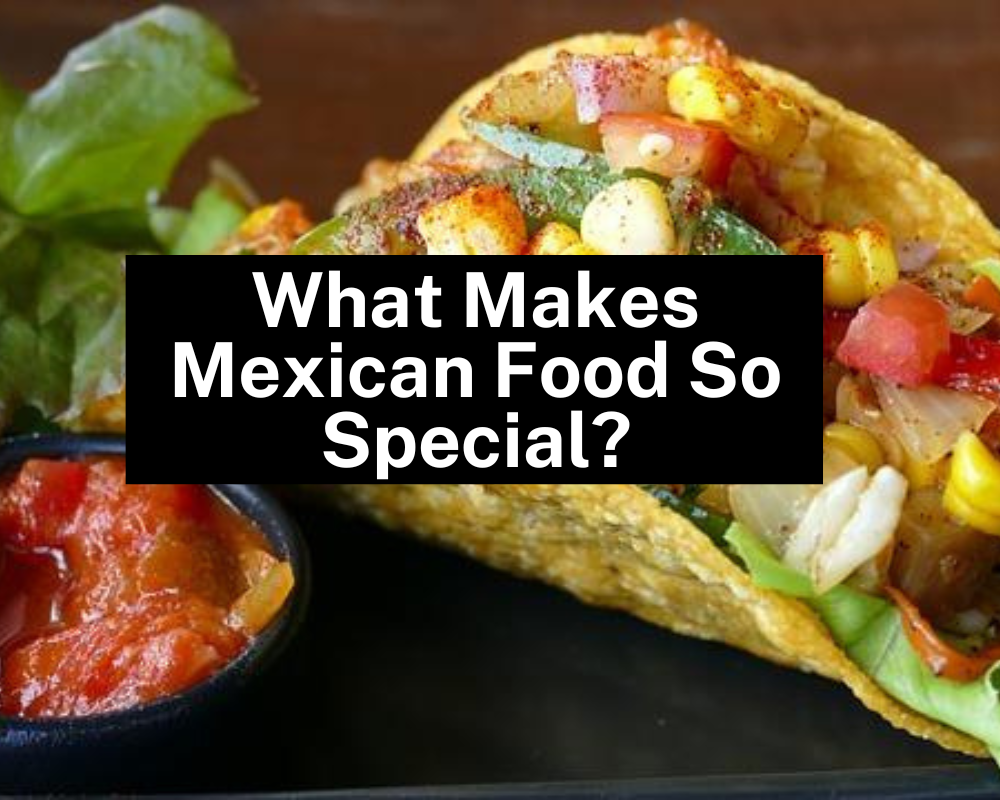What Makes Mexican Food So Special?
Mexican cuisine is renowned worldwide for its rich and diverse flavors, vibrant colors, and unique ingredients. The cuisine is celebrated for its rich cultural heritage. From the sizzling street tacos to the complex and nuanced mole sauces, Mexican food has a special place in the hearts and palates of people around the world.
It’s a cuisine that’s deeply ingrained in the heart and soul of Mexico, reflecting a complex history and a fusion of indigenous, European, and other culinary influences. What sets Mexican food apart and makes it so special? Let’s explore the key factors that contribute to the uniqueness of Mexican cuisine.
5 Reasons Mexican Cuisine is Devoured by The World
1. Corn: The Soul of Mexican Food
If there is one ingredient that can be called the soul of Mexican food, it is undoubtedly corn. Corn has been cultivated in Mexico for thousands of years and is used in an astonishing array of dishes. It’s ground into masa to make tortillas and tamales, and it’s also used to make pozole, atole, and a wide variety of corn-based snacks. Corn plays such a central role in Mexican cuisine that it’s difficult to imagine Mexican food without it.
The preparation of corn-based dishes is a labor-intensive process that showcases the deep connection between Mexican culture and its food. Making masa, the dough used for tortillas and tamales, involves nixtamalization, a traditional method of soaking dried corn in an alkaline solution to make it more nutritious and easier to work with. This process has been passed down through generations, maintaining the authenticity of Mexican cuisine.
2. Regional Diversity
Mexico’s vast and varied geography contributes to the regional diversity of its cuisine. From the coastal regions to the arid deserts and lush jungles, each area has its unique culinary traditions. Let’s look at some regional specialties:
- Oaxaca: Oaxaca is famous for its seven moles and a strong indigenous culinary tradition. Dishes like ‘Tlayudas’, large tortillas topped with various ingredients, and ‘Chapulines,’ fried grasshoppers, are regional specialties.
- Northern Mexico: This region is renowned for its beef dishes. Carne asada, a marinated and grilled beef, is a staple. Flour tortillas, rather than corn, are commonly used for tacos in this region.
- Veracruz: Situated on the Gulf of Mexico, Veracruz’s cuisine is heavily influenced by seafood. You’ll find dishes like Pescado a la Veracruz Ana, a fish dish prepared with tomatoes, capers, and olives.
Each region of Mexico has its unique ingredients, flavors, and cooking techniques, making it a culinary adventure to explore the entire country. If you’re someone living far away from Mexico but still wish to indulge in these flavor-packed meals, try searching for a Mexican buffet in your area.
Buffets allow you to eat to your heart’s content at a relatively affordable price. You’ll get to try a lot of Mexican dishes by going to a buffet. Search for the best buffet in your area; people living in Houston can search for the best Mexican buffet in Houston and enjoy a yummy meal.
3. A Fiesta of Flavors
Mexican food is celebrated for its bold and vibrant flavors. It’s the combination of fresh ingredients, herbs, spices, and chili peppers that makes Mexican dishes so distinctive.
Chiles, in particular, are a cornerstone of Mexican cuisine. They come in various forms, from the mild and fruity poblano to the fiery habanero. Each chili pepper adds its unique flavor and heat to dishes, allowing for a wide range of taste experiences.
Salsas are another essential component of Mexican cuisine, and they vary in flavor, texture, and heat. From the creamy avocado-based guacamole to the smoky, tomato-based salsa roja, salsas are versatile and can elevate the simplest of dishes.
Mexican cuisine’s emphasis on freshness and seasonality ensures that these salsas burst with flavor, whether it’s from ripe tomatoes, fragrant cilantro, or pungent garlic.
Cilantro, another beloved herb, adds a bright, citrusy note to many dishes. It’s often used as a garnish, contributing to the visual appeal of Mexican cuisine.
And let’s not forget about the fragrant epazote, a herb used in dishes like black beans and tamales, adding a distinctive earthy flavor.
4. The Art of Mole
One of the most intricate and revered components of Mexican cuisine is mole. Mole is not just a sauce; it’s an art form. There are numerous types of moles, each with its distinct flavor profile and set of ingredients.
Mole poblano, for instance, is a rich and complex sauce made with chocolate, various chili peppers, and spices. Mole Verde, on the other hand, is a green sauce made with tomatillos, herbs, and chili peppers. The preparation of mole often involves toasting, grinding, and simmering ingredients for hours, resulting in a sauce that’s both savory and deeply flavorful.
The origins of mole can be traced back to pre-Hispanic times when indigenous people combined chocolate with chili peppers and spices in their cooking. The Spanish introduced new ingredients like almonds, cinnamon, and raisins, contributing to the evolution of mole into the complex, multi-layered sauces we know today.
Mole is typically served over chicken or turkey, making it a centerpiece of festive occasions and celebrations in Mexico.
Read: Superfood Smoothies: Delicious and Nutritious Drinks to Boost Your Day
5. Street Food and Tacos
In the bustling streets of Mexico, you’ll find a vibrant and diverse street food culture that’s hard to match anywhere else. Street food vendors offer an array of mouthwatering delights, but perhaps none are as iconic as tacos.
Tacos are the epitome of Mexican fast food, and they come in countless varieties, each a unique expression of flavor and tradition. They are a simple yet perfect example of the ingenuity of Mexican cuisine. They consist of a tortilla, typically corn, filled with an array of ingredients.
From the classic al pastor, with marinated pork and pineapple, to the spicy chorizo and tender lengua, there’s a taco for every palate. Toppings like onions, cilantro, and salsas add layers of flavor and texture.
It’s not just the taste but the experience of eating tacos that makes them special. The act of standing at a street taco stand, watching the taco vendor deftly prepare your order, and then savoring each bite is a cultural experience in itself.
Street tacos capture the essence of Mexican food, offering an explosion of flavors and a sense of community.
Conclusion
In conclusion, what makes Mexican food so special is its deep cultural roots, diverse and flavorful ingredients, and the passion with which it is prepared and shared. It’s a cuisine that celebrates life, history, and the vibrant flavors of a nation. Whether you’re enjoying street tacos, indulging in a rich mole, or savoring a refreshing margarita, Mexican food is an experience that leaves an indelible mark on all who partake in its delights.


